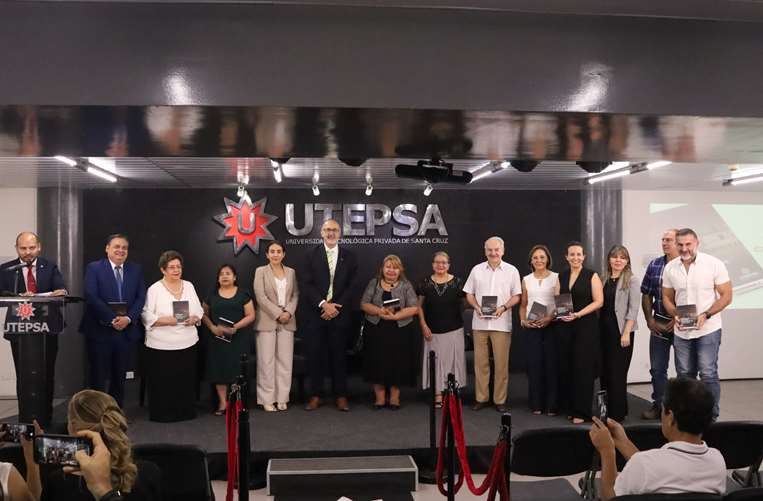October 1, 2024, 3:00 PM
October 1, 2024, 3:00 PM
There are names in the long economic history of Santa Cruz that are a symbol and a legacy that endures to this day. Thus, the great milestones that marked the development in the regional historical pages are recorded by the book ‘History of the commercial houses of Santa Cruz’, by the authors Juan Carlos Peña Gutiérrez and Alejandra Caballero Contreras, which documents the struggles and successes of commercial establishments in Santa Cruz.
The story begins with the rubber boom and rubber fever, in the 1880s, which not only transformed eastern Bolivia and the region, but also connected it with international markets, sowing the seed for the arrival of immigrants, mainly Europeans. and Arabs. Thus, Santa Cruz commerce began to take shape not only with the merchandise, but with the vision, knowledge and spirit of progress of these immigrants who founded commercial houses that became pillars of the city: Casa Maravilla, Casa Tórrez, Casa Dabdoub, Farmacia Telchi, Swiss Importer, Casa Jerusalem, Bazar Girasol and Casa Hércules; on the commercial route, Florida Street and its surroundings. The authors hope to continue with other houses in a second edition.
The city, capital of the department, was already beginning to emerge as a thriving economic center and an expanding market that generated opportunities and jobs. Now, in the era of digital modernity and business acceleration, each company and business established in Santa Cruz is a direct heir to the commercial houses that were established more than a century ago.
The book is a gift from the Private Technological University of Santa Cruz (Utepsa) to Santa Cruz, on the occasion that this university celebrates 30 years of institutional life. The presentation of this literary work was held before an academic audience made up of course leaders, Utepsa teachers, special guests, students and relatives of the founders and owners of these houses.
The authors, Peña y Caballero, reflect that its content is more than a collection of business anecdotes, but is a tribute to the resilience, effort and entrepreneurial spirit that has shaped the identity of Santa Cruz de la Sierra and the region, rescuing the stories of the city’s most iconic business houses by capturing their impact on the region. The work transcends beyond the commercial transactions of the first Santa Cruz merchants; It is an appreciation of the historical heritage and is also an inspiration to future new generations of Santa Cruz entrepreneurs.
The author Alejandra Caballero expresses, from the point of view of the contribution of tourism management of the historic center of the city of Santa Cruz, highlights that they not only wanted to capture the history of commercial houses and enterprises, but also from tourism.
International visitors constantly come to Utepsa and try to explain the value of the Old Town as a heritage site. And with the work written as a result of the interviews, they were able to understand the essence and beginning of Santa Cruz, as a business epicenter and the economic engine of Bolivia. Caballero affirms that they began the course of the book based on the tourist map of the architect Benicia Chávez.
“First of all, let us, the locals, understand that we have the privilege of being able to have eight houses. We wanted to highlight Florida Street where they are currently in force and they are houses that are more than 90 years old and are history that is in the present,” Knight maintains. He comments that entering these houses and taking the tour is being in the present, but returning to the past where Spaniards, Germans, Italians, Arabs, Syrians and Jews showed and taught their products and work. “We don’t want to stay in a book. This is a tourist route that will be left to the Tourism Directorate, there will be a second stage where we want the house to have a QR so that visitors can scan and learn about the history,” says Caballero.
According to Peña, the research celebrates achievements that transcend the pages of a book and becomes a tribute to the very essence of Santa Cruz’s entrepreneurial spirit. “The book that summons us is not only a compilation of data and historical facts, but it is a window to the past and a love letter to the city that has been a cradle of brave pioneers who with vision and perseverance forged the economic and social fabric that sustains us.”
“Writing this book has been a journey full of discoveries, challenges and moments of deep reflection. A land full of memory, but also full of emotions. Each business house, each venture that we have documented contains a narrative of effort, sacrifice and dreams fulfilled, in many cases beyond what was imaginable,” he adds.

“This book is also a guide for future generations of young people from Santa Cruz; The success that we enjoy today as a city has not been a product of chance (…) it is important that today’s young entrepreneurs understand that the path to success is paved by the efforts of those who lived before,” Peña remarks. Thanks for the information provided by Marcelo Araúz and Mario Arrien.
Both authors specify that this work of gift to Santa Cruz is not only a tribute to past generations, but also an invaluable resource for future research and the promotion of cultural tourism. One of the pillars of the book is the illustrated map of the tourist circuit of the most emblematic commercial houses between the 1960s and 1980s, prepared by the architect Benicia Chávez and the ‘Santa Cruz Walk’ project. It is a key work to understand the background and shows that history is still alive in every corner of the city.
For the rector of Utepsa, Rubén Darío Dabdoub, the story of the foreign adventurers who arrived in Santa Cruz ends with happiness because these people “found paradise and began to mix with that population of entrepreneurs that was isolated by the situation in the country.” . Consider that this ambition to bring the world from outside revived the entrepreneurship that Santa Cruz people always had in their DNA.
For the vice chancellor, Mónica Arauco, the presentation of this work, when they began planning for the 30 years of Utepsa, fulfills the mandate of the superior council and board of directors.
“More than receiving something, it was going to be interesting to be able to give something to the community. We believe that this book is a very powerful tool for the Academy because it will allow us to carry out economic, strategic and historical analyses, but mainly it is a tribute to our entrepreneurs who have paved the way for those of us who have come after,” he emphasizes. The general secretary, Pura Zapata, was also at the event.


















